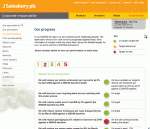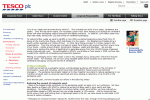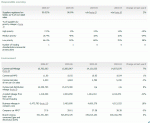Sometimes the choices put in front of you are a veritable chocolate box of decisions. Strawberry or Coffee; Praline or Brazil? Life is sometimes just far too short to come to a final decision.
The same applies when reviewing the sustainability sections of the major food and drink retailers’ websites. There are food miles; working conditions (both in the UK and abroad); organic, fair trade and ethical considerations… (deep breath)
…. vegan and vegetarian, halal and kosher requirements; waste and packaging; additives, colourings and preservatives … and, of course, the dreaded plastic carrier bag.
Out of these one stands out: packaging. It doesn’t matter how near or far your food’s source or what its moral, spiritual or religious provenance is, it still need to be in something when it leaves the shop.
So how do the three FTSE 100 retailers, Tesco, Sainsbury and Morrison, approach the issue of packaging on their websites? How about their nearest private rival, Waitrose, part of the John Lewis Partnership (JLP)? It’s time to browse the box of chocolates and find out.
Unwrapping Packaging
Central to the drive to reduce packaging in across the food retail sector is the Courtauld Commitment. This initiative was launched in 2005 by the Waste and Resources Action Programme (WRAP), a far reaching government backed programme.
The key milestones in this commitment are to design out any increase in packaging waste by 2008 and start delivering absolute reductions in packaging waste by 2010.
In order to fulfil this last commitment the retailers have made the following commitments:
- Sainsbury: reduce packaging by 5% relative to turnover by 2010 against a 2004/05 baseline
- Tesco: reduce the amount of packaging on both branded and Tesco own-label products by 25% by 2010
- Waitrose: nothing specific as waste production per £m turnover is already falling, just the commitment to keep it falling year on year
- Morrison: use 15% less own-brand packaging by 2010
Uninformative information
The retailers use different tactics to present their progress towards these targets on their websites.
Tesco, Sainsbury and Waitrose all have separate sections on sustainability as well as an online version of their sustainability report. Morrison has neither. It simply has a page with links to its sustainability reports in PDF format.
The latest of Morrison’s reports states that it has reduced its packaging by 7%. There are no further details or figures so it is impossible to tell whether Morrison believes it is on course to achieving its target or not.
Sainsbury’s sustainability section is, in effect, a summary of the report itself and so does not include any discussion of packaging. However, this section does have a straightforward presentation of the company’s performance indicators.
These are depicted using a traffic light system and show that the packaging target was one of only two which are not on course to being met. However this is the only information which is on offer.
This is typical of the fundamental problem with traffic light systems. They’re very good for giving a quick, eye-catching summary but without the underlying data they can be all but useless for comparison purposes.
Light from the end of the Tunnel
Tesco is also hard to pin down on the specifics. To be fair the packaging target was only announced in April 2007 so it would be difficult to report comparative measurements for it.
However Tesco, like Sainsbury, use a traffic light system for their indicators and also don’t publish the underlying data.
Instead various figures are mentioned which give a reduction in packaging between 40 and 90%, depending upon the product range in question.
Similarly a reduction of 10,500 tonnes for produce packaging is also mentioned, but without knowing how much packaging was used before the reduction the figure is almost meaningless.
Waitrose, on the other hand, has a somewhat different approach. Their initial discussion of packaging is on their consumer website, while the FTSE100 companies all have sustainability sequestered on their corporate sites.
In addition, Waitrose’s full figures are available in a surprising amount of detail. This includes the number of tonnes of packaging produced and the calculation of how many tonnes were produced per million pounds of sales made.
Beware the Dark Horse
In total, Waitrose report against over 70 sustainability performance indicators, all of which are given as year-on-year figures rather than simplified traffic lights. This may make the company’s performance slightly less eye catching, but it does make it transparent and readily comparable.
These are qualities which will become more and more important as sustainability reporting starts to take root. A company may not need to report 70 indicators, but it certainly helps to put its operations into context.
Consumers, analysts and journalists will be attracted to those companies who help their stakeholders by presenting themselves in such a straightforward and uncomplicated light.
Those who prefer obfuscation may find their chocolate box of figures, not matter how prettily presented, ends up in the bin in favour of a less decorated, more flavoursome variety.
A former CTO, Chris has a broad and varied background. He’s been involved with blue chips, consultancies & SMEs across a wide variety of sectors and has worked in Europe, the Middle East and Australia.
In 2007 he decided to combine his knowledge of business and IT with his passion for all things sustainable and has been busy writing ever since. However, his greatest ambition remains to brew the perfect cup of coffee.



